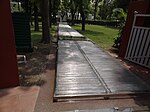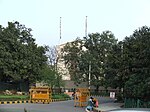Delhi Sadar (Lok Sabha constituency)
1956 establishments in Delhi2008 disestablishments in IndiaConstituencies disestablished in 2008Constituencies established in 1956Defunct constituencies of the Lok Sabha ... and 2 more
Lok Sabha constituencies in DelhiUse Indian English from May 2018
Delhi Sadar Lok Sabha constituency was one of the Lok Sabha (parliamentary) constituencies in the National Capital Territory of Delhi from 1956-2008.
Excerpt from the Wikipedia article Delhi Sadar (Lok Sabha constituency) (License: CC BY-SA 3.0, Authors).Delhi Sadar (Lok Sabha constituency)
New Delhi
Geographical coordinates (GPS) Address Nearby Places Show on map
Geographical coordinates (GPS)
| Latitude | Longitude |
|---|---|
| N 28.6 ° | E 77.2 ° |
Address
110011 New Delhi (Chanakya Puri Tehsil)
Delhi, India
Open on Google Maps




